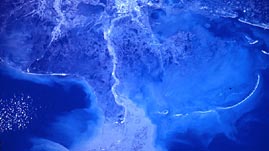Teachers' Domain - Digital Media for the Classroom and Professional Development
User: Preview

Source: Produced for Teachers' Domain
Powered by the force of gravity, the world's rivers deliver about 20 billion tons of loosened rock and soil to the oceans each year. For the past 100 million years, redeposited sediment has gradually increased the size of the Mississippi River Delta. But over the past several decades, the coast of southern Louisiana has been losing rather than gaining land. These aerial views from NASA, the Lunar and Planetary Institute, and U.S. Geological Survey illustrate how river management practices and severe weather events, including Hurricane Katrina, dramatically changed the size and shape of the Louisiana coastline and the Mississippi River Delta in the 20 years between 1985 and 2005.
Deltas, fan-shaped deposits of sediment, form where rivers flow into oceans. Deltas consist of fine silt, sand, and clay particles that originate far upstream and settle when the river water mixes with seawater. As the river deposits layer upon layer of sediment, it eventually creates a platform that breaks the surface of the water. This blocks the main river channel, creating side streams called distributaries that carry the water and sediment to the ocean. This branching broadens the delta basin, which includes all of the surrounding land and shallow waters.
The Mississippi River stretches 3,780 kilometers (2,350 miles) from its headwaters in Minnesota to the Gulf of Mexico, and transports a half-billion tons of sediment each year. The Mississippi River Delta Basin encompasses more than a half-million acres in southern Louisiana. Of the 101,000 acres of low-lying land created from river deposits within the basin, about 60 percent is made of bayous, marshes, and other coastal wetlands.
Coastal wetlands are a critical resource, providing habitats for a variety of birds, fish, and shellfish. The abundance of such economic resources has supported the settlement of these regions by humans. Wetlands provide an important buffer zone, protecting the mainland against hurricane winds and storm surges. In addition to the millions of tons of cargo shipped down the Mississippi each year, one-fifth of the nation's supply of natural gas and $30 billion per year in petroleum products are either extracted from or are transported through Louisiana's coastal wetlands.
Over the past 50 years, the sediment load of the Mississippi River Delta Basin has been drastically reduced by a combination of natural and human-induced factors. Natural factors include events such as hurricanes, tidal erosion, and sea-level rise. Human-induced factors include dams, which trap sediment behind their walls, and other flood-control and navigation enhancements that prevent the river from scouring sediment from its banks and depositing them on the coastal wetlands. Deprived of new sediment, the entire delta basin is now losing land faster than it is being created.
At the current pace, Louisiana will lose more than 527,000 acres of coastal wetlands over the next 50 years, leaving less than 5 percent of the wetland area it had in the 1930s. As a result, New Orleans and other coastal cities will be open to the full force of Gulf of Mexico weather. To address this unfolding crisis, government agencies are debating whether to maintain the present course of the river and work to ameliorate its water flow and sediment distribution, or, more radically, to divert the river, which would create a new delta and substantially increase the size of wetlands over the long run.
In 2005, Hurricane Katrina dramatically increased the rate of wetland destruction along the Louisiana coast, damaging more than 700,000 acres of marsh in a single day. Satellite images taken before and after Katrina show the striking reduction in the size of the Louisiana coastline that resulted. In fact, some parts of the Mississippi River Delta Basin, such as the Chandeleur Islands lost approximately half of their land mass as a result of Katrina's powerful storm surge. If the current trend of wetland loss continues, what once served as important wildlife habitat and the region's first line of defense against tropical storm damage, may be lost forever.
 Loading Standards
Loading Standards Teachers' Domain is proud to be a Pathways portal to the National Science Digital Library.
Teachers' Domain is proud to be a Pathways portal to the National Science Digital Library.
